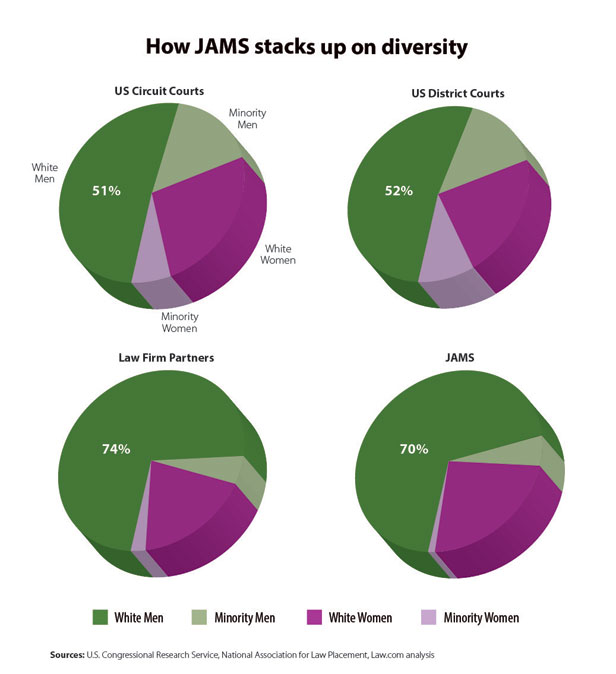Out today on Law.com is an article discussing the current state of the business of ADR and I appreciate the shout out to the ABA DR section survey (published here) from the author Ben Hancock. His article is the first in a series addressing this problem. As the writer notes,
It’s no secret that Big Law firms and courthouses around the country have struggled to add more women and minorities to their ranks. But even amid incremental progress on those fronts, alternative dispute resolution, or ADR, has been a stubborn enclave of homogeneity.
Statistics are hard to come by and most ADR organizations are reluctant to provide data on their panels. But according to a Law.com analysis of the more than 350 neutrals affiliated with JAMS, one of the largest national providers of ADR services, 25 percent are women and 7 percent are minorities. More than 95 percent are over the age of 50….
The American Arbitration Association does not publicly list information about the roughly 7,000 neutrals registered on its rosters. But in business disputes last year, AAA reported that 22 percent of arbitrators selected were either a woman or a minority.
Those numbers show the profession falling significantly short of federal courts in terms of diversity, and coming up on par with the ranks of law firm partners.

But neutrals and attorneys interviewed for this article agreed that available statistics mask the true extent of the problem. Even if providers have a diverse roster of people to choose from, what matters is who ultimately wins work from attorneys and their clients. Many sources agreed that, within the realm of business disputes, there is a small pool of “repeat players” who are predominantly white and male.
Women also miss out when big dollar amounts are at stake. A survey by the American Bar Association’s Section of Dispute Resolution published in 2014 found an inverse relationship between the amount of money in dispute and the likelihood that a woman would be chosen as the arbitrator or mediator to help resolve the matter. The study shores up the perception among neutrals that even when capable women are available, they are seldom chosen for the big-ticket cases that make their practice economically viable.


ADR has become such a major alternative to litigation that it is discouraging, as a minority and woman, to see that women and minorities be so underrepresented. It appears that there are no initiatives to get women and minorities more opportunities as neutrals. This is especially apparent when ADR service providers will not release their demographic statistics; and what they do provide does not truly demonstrate the true deficit of women and minorities serving as neutrals in ADR. Even beyond being a women and minority, from the numbers, with 95 percent of neutrals being over the age of 50 it does not allow for young professionals to break into the field. Diversity is so important. Diversity fosters creative solutions and more effective procedures. Diversity allows people with different experiences add their perspective to the field to make it more dynamic. For example, young people could really transform the field with all of our extensive knowledge and use of technology. The field of ADR does not allow this to happened without diversity. I am not sure what has to be done, but diversity has to be increased in ADR. Unique perspectives and experiences can only help make the field more dynamic.
Implicit bias continues to be a huge problem for well-qualified women and people of color in the legal community as evidenced by this article. It is especially frustrating that, when given the opportunity to choose an arbitrator, parties continue to be affected by their bias in making their choice. Fixing this problem continues to be difficult, because when the issue is brought up no one wants to be labeled a ‘racist’; but implicit bias (propagated through social conditioning) affects everyone in this country. This isn’t an us versus them issue. This is something we all need to be held accountable for if we want things to change.
Especially telling, at least to me, is that this problem is more pronounced in ADR than federal courts. One would think that a business in which people are encouraged to communicate more would foster a more diverse workforce.
I’ve been particularly upset in our field about the lack of age diversity among neutrals. I hate having honest conversations with law students (and others) about the ADR possibilities that exist shortly after graduation.
In my geographical region, young mediators are primarily limited to family law and community mediation (two areas I personally find quite rewarding). Young arbitrators are limited to FINRA panels. Even mediators who started mediating in their early 30s with years of experience in some areas have an extremely difficult time getting civil cases.
The reasoning by the attorneys in neutral selection is predictable. They seek experienced civil trial attorneys (20+ years in civil practice), but rarely give other mediators a chance. If the hiring attorneys insist in 20+ years of trial experience and partner-level achievement at a private law firm, they are necessarily limiting their pool to candidates that are overwhelmingly older white men.
I don’t have an answer, but perhaps recognizing a problem is a decent first step.